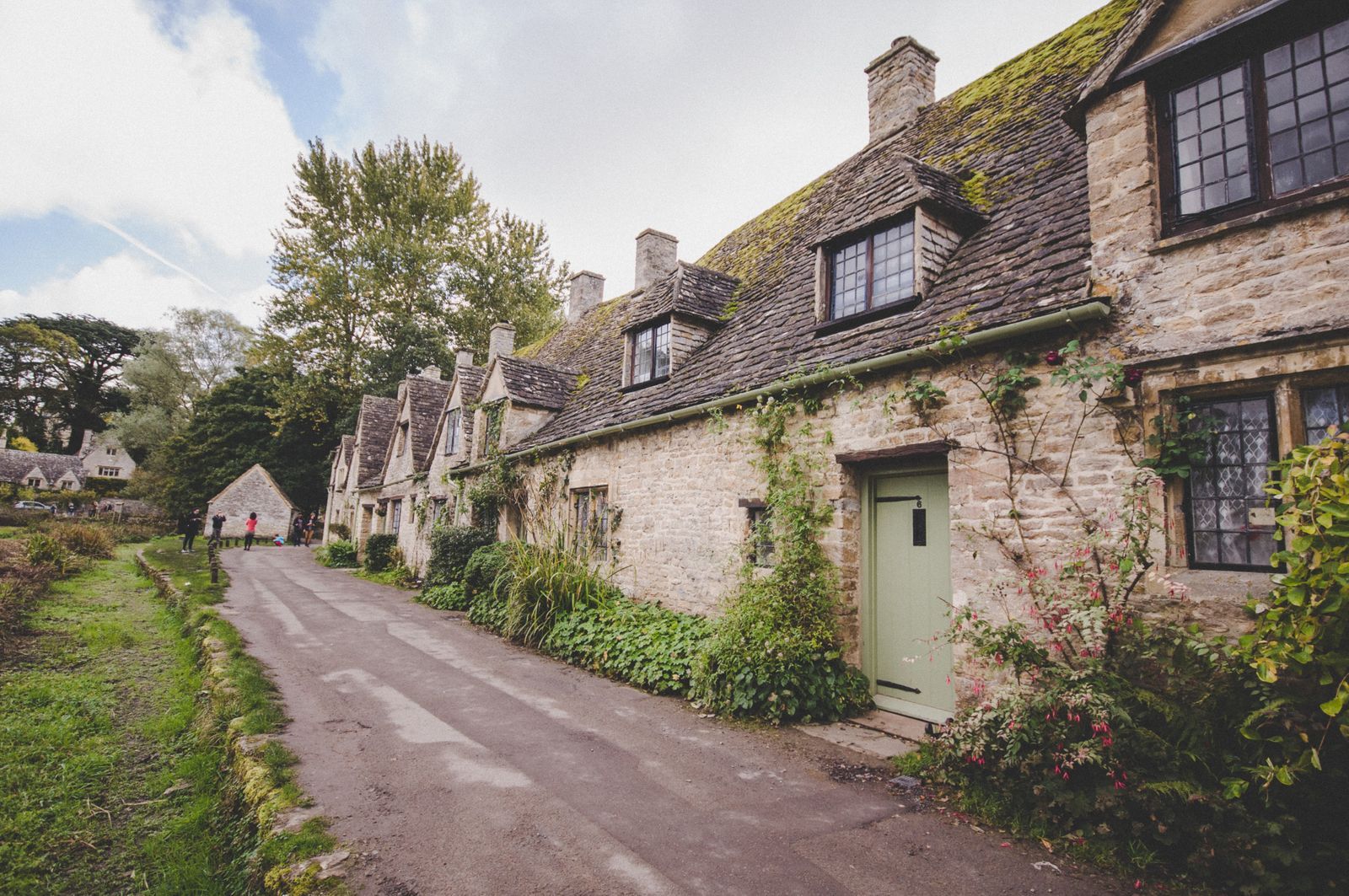
Types of Period Property
Tudor (1480’s – 1603)
Characterised by classic black & white woodwork, Tudor buildings are some of the earliest to survive in any significant quantity. Half-timbered with white-painted wattle and daub painted walls, these houses had steeply-pitched roofs and small-paned casement windows, often with a jetty overhanging the street.
They are the very essence of Olde England, pretty black and white dwellings with great character and centuries of history steeped in their walls. Tudor homes were built at a time when the British were feeling less fearful for their safety, so houses were more outward-facing than in the Middle Ages when the need to defend the family led to many houses facing inwards onto a central courtyard. Glass was the latest innovation, but was expensive to produce, so was made into tiny panes, held together by lead strips.
The wealthier you were, the more windows your home had – and it was common practise to take them with you when you moved house.
What are the main characteristics of a Tudor property?
- E or H-shaped layout
- Tall narrow doors and windows
- Dirt or wooden floors, covered with rush matting
- Small herb garden, mainly for medicinal use
- Tudor rose, thistle and fleur de lys decorative symbols
- Oak furniture including 4-poster bed
Examples of Tudor Period Homes
Stuart Period (1603 – 1714)
At the beginning of this period, life for the Middling Sort – forerunners of the middle classes – centred on The Hall, the first floor room where the entire household, gathered to dine, socialise and entertain guests. But from the 1660s, the parlour and the dining room became the main living areas for the family, signalling a change in the way households lived with a greater separation between the family, their servants, apprentices and other employees. The Civil War in the 1640s and 50s and the Great Fire of London in 1666 both had a marked effect on the way British homes evolved. After the blaze destroyed 13,200 wooden-built houses across the capital in four days, Parliament decreed that homes must be built of brick.
And the War sent many gentlemen to the Continent to flee the fighting or later to follow Charles II into exile, where they were hugely influenced by French, Dutch and Italian architecture, leading to a flurry of buildings which reflected the latest European trends, and which eventually filtered down from the nobility to the masses.
Life in London was also increasingly cosmopolitan, with merchants trading as far afield as india, the Far East and Africa. The economy was growing and the Middling Sort were prospering, and able to buy expensive items from overseas like silver, porcelain, colourful textiles, mirrors and clocks to adorn their homes.
It was during this period that servants – most families had at least one or two who could include unmarried female relatives – would be accommodated in smaller rooms at the top of the house.
What are the main characteristics of a Stuart property?
- Small rooms at the top of house for servants
- Beginning of the trend for terraced homes
- Wood panelling
- Elaborate fireplaces
- Richly plastered ceilings
- Spacious parlours
- European influence in rich people’s homes
Examples of Stuart Period Homes
Georgian (1714 – 1830)
Probably one of the most popular period types of country properties. The Georgian period boasts elegant exteriors, spacious rooms & tall ceilings. Properties built in this period were built to be spacious and comfortable, with grand proportions and a heightened sense of space and light.
This was in contrast to the smaller, darker architectural styles that preceded the Georgian era. It was typical in the Georgian era for the first and second storey of a house to be occupied by the owner and their family, while the staff lived on the top storeys. This is why these rooms are typically smaller, with lower ceilings and smaller windows compared to the more elegant rooms at the bottom of the house. Kitchens were on the lower ground floor, away from the main house, as this was the servants’ domain. If you look closely at a Georgian property, often you will see something strange – a bricked-up window.
This peculiar characteristic was caused by the window tax levied on homeowners between 1696 and 1851. The window tax was in the place of income tax – the more windows a home had, the bigger it was and the richer the owner.
So, to avoid paying higher taxes, many homeowners bricked up some of their windows to reduce the rate of tax they had to pay. Rather than reinstate the windows after the tax was lifted, many owners decided to leave the windows as they were.
What are the main characteristics of a Georgian property?
- Townhouses were arranged over three or four storeys
- Sash windows with smaller panes – tall windows on the first two floors and smaller windows on the top storeys
- Symmetrical flat exterior and balanced interior layout
- Stucco-fronted exterior, meaning it is rendered in a plaster material that covers the construction material beneath. In earlier Georgian designs, the ground floor was rendered and the rest of the exterior was exposed brickwork, while in the later Regency style, houses were rendered from top to bottom.
- Render painted white or cream
- Built around garden squares, as the houses did not have their own garden
Examples of Georgian Period Homes
Victorian (1837-1901)
Victorian architecture, not so graceful as the Georgian period but still has good quality workmanship & an orientation designed with a family in mind. The majority of homes built before the Victorian period were owned by the gentry, or at least wealthy landowners, whereas wealth in the Victorian era was spread across society in the wake of the Industrial Revolution and houses became less grand and more accessible.
This meant that it was necessary to build more homes, which is why the Victorian period is characterised by rows of terraced housing on narrow streets. Contrary to popular belief, terraced housing was commonplace before the Victorian era, with many Georgian properties in London built within a terrace. However, it was during the Industrial Revolution that there was a boom in terraced housing, including the ‘back-to-backs’ – these terraced houses were built close to factories for workers to live in and were erected cheaply and quickly, with no garden or proper sanitation. Building of ‘back-to-backs’ became illegal in the late-19th century, which made way for the byelaw terraced houses that we see today, mostly in former industrial areas in the Midlands and the North of England. These byelaw terraces typically open straight out onto the street and are very simple in design.
Internally, high ceilings and large windows were a feature of Victorian homes, but the rest of the layout became a little bit cramped compared to previous Georgian designs, with a long and thin footprint. Often Victorian homes are one room wide, with a narrow hallway leading off into the different entertaining rooms, or two up, two down with just two rooms on each floor.
What are the main characteristics of a Victorian property?
- Coloured brickwork
- High pitched roof
- Ornate gable trim
- Geometric tiled hallways
- A brickwork porch
- Front door to the side of the façade
- Narrow hallway
- Stained glass windows
- Bay windows to sit in, for reading and writing
- Dark furniture and wood floors
- Fireplace in every room
- Patterned wallpaper – typically heavy floral designs
- Elaborate design details that reflect the wealth of the owner and those coming into ‘new’ money
Examples of Victorian Period Homes
Edwardian (1901 – 1914)
Designed with all the mod cons, these houses are considered by many to be the ideal with a good mix of quality workmanship & modern conveniences. The Edwardian period from 1901 to 1910 was short and heavily influenced by The Arts and Crafts Movement.
The movement promoted simple design and an appreciation for the handmade in retaliation to mass production in the Victorian age. Following the boom in property construction during the Victorian era, Edwardian housebuilders were forced to build homes in the suburbs where there was more space, which created the ‘garden suburbs’, like that in Hampstead.
So, unlike the smaller, darker Victorian homes, Edwardian houses were more squat, wider and roomy, with bigger hallways and more windows.
It’s common for an Edwardian property to have a front garden and be set back from the pavement, as there was an ever-increasing desire for privacy at that time. Living rooms would sometimes have windows at both ends, covered by a small sloping roof on the outside.
What are the main characteristics of an Edwardian property?
- Houses built in a straight line
- Red brickwork
- Porch with wooden frames
- Mock-Tudor cladding and timbers at the top of the house
- Wide hallway
- Parquet wood floors
- Wider, brighter rooms
- Simple internal decorative features

